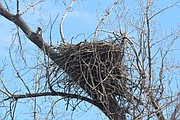Nests are something to get 'egg-cited' over this spring!
Don Bartling Contributing Writer | Hagadone News Network | UPDATED 6 years, 8 months AGO
“There is some of the same fitness in a man’s building his own house that there is in a bird’s building his own nest. Who knows but if men constructed their dwellings with their own hands, and provided food for themselves and families simply and honestly enough, the poetic faculty would be universally developed, as birds universally sing when they are so engaged.”
— Henry David Thoreau 1817-1862
Nesting season is already underway! Spring house cleaning may be in order for us, but spring nest building is the mission of most birds. That is something to get “egg-cited” about.
Bird nests are truly an amazing feat of engineering. Imagine building your home strong enough to weather a storm, large enough to hold your entire family, insulated enough to shelter them from cold and heat, and waterproof enough to keep out rain. Now build it without any blueprints or directions, and without the use of your hands! Birds do!
Nesting material usually consists of natural elements found in the immediate area. Most nests consist of plant fibers, sticks, mud, dried grass, leathers, fur, or soft fuzzy tufts from thistle. Some birds, including hummingbirds, use spider webs to glue nesting materials together. Nesting material is limited to what a bird can hold or carry. Because of this, a bird must make many trips afield to gather enough materials to complete its nest. Most nests take at least four days or more, and hundreds of trips to build.
There are basically four types of nests built by birds: the ground nest, platform nest, cup nest, and pendulous nest.
The simple ground nest is scraped out of the earth. A shallow depression that usually contains no nesting material, it is made by birds such as the killdeer.
The platform nest represents a more complex type of nest building. Constructed of small twigs and branches, the platform nest is a simple arrangement of sticks which forms a platform and features a small depression to nestle the eggs. Eagles and osprey use the platform nest.
The cup nest is a modified platform nest, used by three-quarters of all songbirds, such as robins and western tanager. Constructed from the outside in, a supporting platform is constructed first. This platform is attached firmly to a tree, shrub, rock ledge or the ground. Next the sides are constructed of grasses, small twigs, bark or leaves, which are woven together and often glued with mud for additional strength. The inner cup, lined with feathers, animal fur, soft plant material or animal hair, is constructed last. The mother bird uses her chest to cast the final contours of the inner nest.
The pendulous nest is an unusual nest, looking more like a sock hanging from a branch than a nest. Inaccessible to most predators, these nests are attached to the ends of the smallest branches of a tree, and often wave wildly in the breeze. More commonly used by tropical birds, this complicated nest type has also been mastered by orioles and kinglets.
In general, the female bird builds the nest. She gathers nesting materials and constructs a nest, with an occasional visit from her mate to check on the progress. In some species, both parents contribute equally to the construction of a nest. A male bird might forage for precisely the right sticks, grass or mud, but it’s often the female that forms or puts together the nest. She uses her body to form the egg chamber. Rarely does the male build a nest by himself.
Whether birding, hiking or just sight-seeing, get out and enjoy Boundary County’s outdoors!
ARTICLES BY DON BARTLING CONTRIBUTING WRITER

About the Douglas fir
“The big tree is nature’s forest masterpiece, and so far as I know, the greatest of living things.” — John Muir 1838-1914 “Father of the National Parks” and author.

Winter on the hoof: How deer, elk and moose cope with the snow!
“When snow falls, nature listens.”




